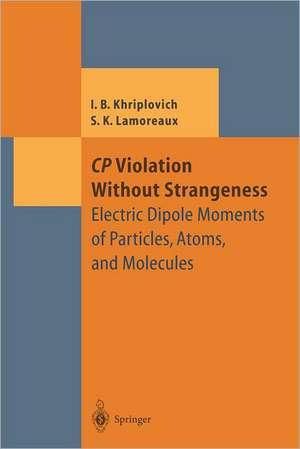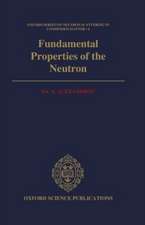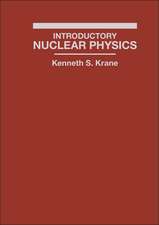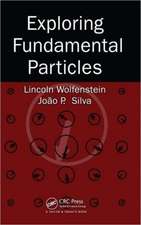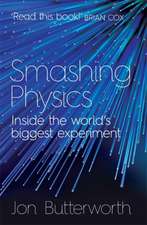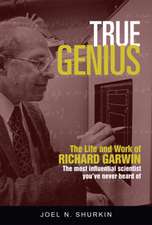CP Violation Without Strangeness: Electric Dipole Moments of Particles, Atoms, and Molecules: Theoretical and Mathematical Physics
Autor Iosif B. Khriplovich, Steve K. Lamoreauxen Limba Engleză Paperback – 18 sep 2011
Din seria Theoretical and Mathematical Physics
- 20%
 Preț: 697.22 lei
Preț: 697.22 lei - 18%
 Preț: 744.84 lei
Preț: 744.84 lei - 20%
 Preț: 699.50 lei
Preț: 699.50 lei -
 Preț: 396.82 lei
Preț: 396.82 lei - 15%
 Preț: 721.06 lei
Preț: 721.06 lei - 18%
 Preț: 1120.68 lei
Preț: 1120.68 lei -
 Preț: 398.35 lei
Preț: 398.35 lei - 15%
 Preț: 643.65 lei
Preț: 643.65 lei - 15%
 Preț: 508.60 lei
Preț: 508.60 lei - 20%
 Preț: 652.54 lei
Preț: 652.54 lei - 15%
 Preț: 646.75 lei
Preț: 646.75 lei - 15%
 Preț: 654.12 lei
Preț: 654.12 lei - 15%
 Preț: 649.87 lei
Preț: 649.87 lei -
 Preț: 396.24 lei
Preț: 396.24 lei - 15%
 Preț: 653.14 lei
Preț: 653.14 lei - 18%
 Preț: 960.78 lei
Preț: 960.78 lei - 15%
 Preț: 529.92 lei
Preț: 529.92 lei - 18%
 Preț: 1127.78 lei
Preț: 1127.78 lei - 18%
 Preț: 1548.71 lei
Preț: 1548.71 lei - 15%
 Preț: 551.53 lei
Preț: 551.53 lei - 18%
 Preț: 1002.75 lei
Preț: 1002.75 lei -
 Preț: 396.02 lei
Preț: 396.02 lei - 15%
 Preț: 648.89 lei
Preț: 648.89 lei - 18%
 Preț: 783.35 lei
Preț: 783.35 lei - 18%
 Preț: 973.38 lei
Preț: 973.38 lei - 18%
 Preț: 907.90 lei
Preț: 907.90 lei - 15%
 Preț: 655.78 lei
Preț: 655.78 lei - 18%
 Preț: 1118.93 lei
Preț: 1118.93 lei -
 Preț: 390.25 lei
Preț: 390.25 lei - 15%
 Preț: 663.79 lei
Preț: 663.79 lei - 15%
 Preț: 653.79 lei
Preț: 653.79 lei - 15%
 Preț: 645.28 lei
Preț: 645.28 lei - 15%
 Preț: 604.23 lei
Preț: 604.23 lei - 15%
 Preț: 639.25 lei
Preț: 639.25 lei - 15%
 Preț: 590.81 lei
Preț: 590.81 lei -
 Preț: 395.25 lei
Preț: 395.25 lei - 15%
 Preț: 589.33 lei
Preț: 589.33 lei - 19%
 Preț: 543.19 lei
Preț: 543.19 lei - 15%
 Preț: 594.24 lei
Preț: 594.24 lei - 18%
 Preț: 911.17 lei
Preț: 911.17 lei - 18%
 Preț: 957.75 lei
Preț: 957.75 lei -
 Preț: 409.13 lei
Preț: 409.13 lei - 15%
 Preț: 532.23 lei
Preț: 532.23 lei
Preț: 638.11 lei
Preț vechi: 750.72 lei
-15% Nou
Puncte Express: 957
Preț estimativ în valută:
122.11€ • 130.57$ • 101.81£
122.11€ • 130.57$ • 101.81£
Carte tipărită la comandă
Livrare economică 18 aprilie-02 mai
Preluare comenzi: 021 569.72.76
Specificații
ISBN-13: 9783642645778
ISBN-10: 3642645771
Pagini: 248
Ilustrații: XII, 230 p.
Dimensiuni: 155 x 235 x 13 mm
Greutate: 0.35 kg
Ediția:Softcover reprint of the original 1st ed. 1997
Editura: Springer Berlin, Heidelberg
Colecția Springer
Seria Theoretical and Mathematical Physics
Locul publicării:Berlin, Heidelberg, Germany
ISBN-10: 3642645771
Pagini: 248
Ilustrații: XII, 230 p.
Dimensiuni: 155 x 235 x 13 mm
Greutate: 0.35 kg
Ediția:Softcover reprint of the original 1st ed. 1997
Editura: Springer Berlin, Heidelberg
Colecția Springer
Seria Theoretical and Mathematical Physics
Locul publicării:Berlin, Heidelberg, Germany
Public țintă
ResearchCuprins
1. Introduction.- 1.1 Overview of CP Violation Without Strangeness.- 1.2 The Neutron Electric Dipole Moment: Early History.- 1.3 Molecular Electric Dipole Moments and CP Violation.- 1.4 T-Odd Effects Without CP Violation.- 2. Kinematics of Discrete Symmetries.- 2.1 CPT Theorem: Intuitive Approach.- 2.2 T-Even and T-Odd Electromagnetic Multipole Moments.- 2.3 General Structure of Four-Fermion Operators.- 3. General Features of EDM Experiments.- 3.1 Interaction of an EDM with an Electric Field.- 3.2 Ground State Optical Pumping and Detection of Atomic Polarization.- 3.3 Electric Fields and Coherence Times in Various Systems.- 3.4 Magnetic Field Control and Generation.- 3.5 Systematic Effects.- 4. The Search for the Neutron EDM.- 4.1 Properties of the Neutron.- 4.2 Interaction of Neutrons with Matter.- 4.3 Neutron Beam EDM Experiments.- 4.4 Ultracold Neutrons.- 4.5 Neutron EDM Measurements with Stored Ultracold Neutrons.- 4.6 The Future: Superfluid He Neutron EDM with a 3He Comagnetometer.- 4.7 Comparison of Experimental Techniques.- 5. Theoretical Predictions for Neutron and Electron Dipole Moments.- 5.1 The CP-Violating ? Term in Quantum Chromodynamics.- 5.2 Predictions of the Standard Model for Dipole Moments.- 5.3 Spontaneous CP Violation in the Higgs Sector.- 5.4 Phenomenological Approach.- 6. EDM Experiments with Paramagnetic Atoms.- 6.1 The Shielding Problem.- 6.2 Enhancement of the Electron EDM in Paramagnetic Atoms.- 6.3 Overview of Paramagnetic Atom Experiments.- 6.4 The Cs EDM Experiment.- 6.5 The T1 EDM Experiment.- 6.6 Future Prospects for Improving the Electron EDM Limit.- 6.7 EDM Limits of Some Other Elementary Particles.- 7. EDM Experiments with Diamagnetic Atoms.- 7.1 Shielding in the 1S0 System.- 7.2 The 129Xe EDM Experiment.- 7.3 The 199Hg EDMExperiment.- 7.4 3He — 129Xe Comparison.- 8. Atomic Calculations.- 8.1 Wave Function of an Outer Electron at Short Distances.- 8.2 The Electron EDM in Paramagnetic Heavy Atoms.- 8.3 CP-Odd Electron—Nucleon Interaction.- 8.4 Electron EDM in Diamagnetic Atoms.- 8.5 CP-Odd Nuclear Moments.- 9. T Violation in Molecules.- 9.1 Enhancement of an Applied Field by a Polar Molecule.- 9.2 TIF Beam Experiments.- 9.3 What Have We Learned from the TIF Experiment?.- 9.4 Paramagnetic Molecules.- 9.5 What Will Be Gained from Experiments with Paramagnetic Molecules?.- 10. CP-Odd Nuclear Forces.- 10.1 CP-Odd Mixing of Opposite-Parity Nuclear Levels.- 10.2 Nuclear Moments Induced by T- and P-Odd Potentials.- 10.3 Enhancement Mechanisms for T- and P-Odd Nuclear Multipoles.- 10.4 Theoretical Predictions and Implications.- 11. What Do We Really Know About T -Odd, but P-Even Interactions?.- 11.1 Long-Range Effects.- 11.2 TOPE Fermion—Fermion Interactions.One-Loop Approach.- 11.3 TOPE Fermion—Fermion Interactions.Two-Loop Approach.- 11.4 Conclusions on TOPE eN and NN Interactions.- 11.5 T-Odd ? Decay Constants.- References.
Textul de pe ultima copertă
The possibility of the existence of permanent electric dipole moments (EDMs), which would be evidence of a breakdown of time-reversal symmetry, has been of interest to physicists for neary half a century. This question gained renewed interest with the discovery in 1964 of CP violation in the decay of the K0 meson. Experimental searches for EDMs have severely constrained the possible theories that describe the CP-violation.
The fundamental physical theories put forward to describe the K0 system are described, and application to the calculation of EDMs of the electron, the neutron, atoms, and molecules is thoroughly reviewed. The theoretical description is embellished by a comprehensive review of the experimental seraches for EDMs, along with an overview of likely future experimental trends.
The book represents the first complete and simultaneous description of both theoretical and experimental techniques related to the issues of EDMs. It is intended for advanced graduate students who want a solid introduction to the theoretical and experimental issues, and for workers in the field who want a comprehensive review and overview of current work.
The fundamental physical theories put forward to describe the K0 system are described, and application to the calculation of EDMs of the electron, the neutron, atoms, and molecules is thoroughly reviewed. The theoretical description is embellished by a comprehensive review of the experimental seraches for EDMs, along with an overview of likely future experimental trends.
The book represents the first complete and simultaneous description of both theoretical and experimental techniques related to the issues of EDMs. It is intended for advanced graduate students who want a solid introduction to the theoretical and experimental issues, and for workers in the field who want a comprehensive review and overview of current work.
